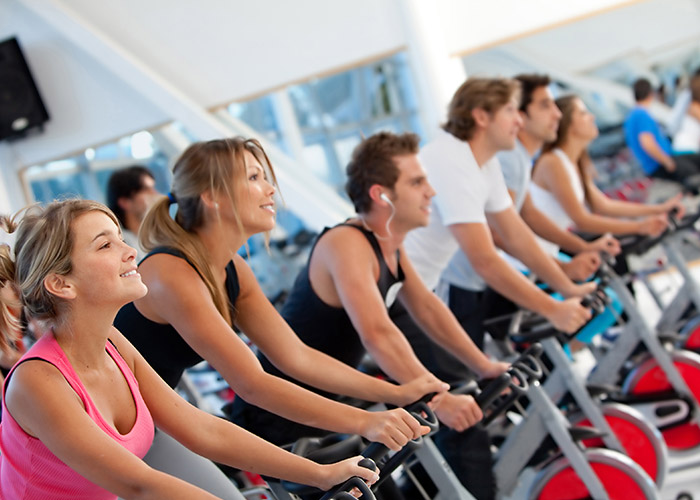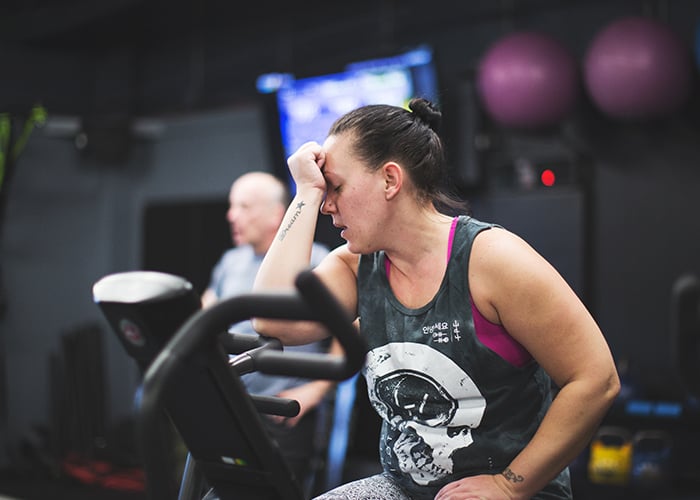Pros and Cons of High-Intensity Exercise
Most fitness enthusiasts really like the idea of high-intensity exercise. We frequently hear folks talking about how challenging their workout was or how much time they spent in the RED zone—one of the heart rate zones we'll go over soon.
High-intensity training is a great way to improve your fitness, but there are some considerations when organizing your workout routine. In this blog post, we will highlight (in brief) some pros and cons of high-intensity exercise, specifically, high-intensity cardio exercise.
We define high-intensity cardio exercise as any form or mode of exercise that gets your heart rate up above 75% of your max heart rate (on average) for 10 minutes or more in duration. In MYZONE terms, that would be the upper portion of GREEN, and all of YELLOW and RED heart rate zones.
There are many different ways to perform high-intensity cardio training: high-intensity steady state training (HISS or threshold training), tempo training, and high-intensity interval training (HIIT) are a few examples.
We have written about high-intensity training multiple times, and have discussed it in our Fitness Friday videos. Here are a few of those resources:
Blogs on the MYZONE website:
- The Yellow Zone
- The Red Zone
- The Red Zone: Common Questions
- Organizing Your HIIT to Maximize Your Workout
- Two Bodyweight HIIT Workouts in 15 Minutes
- The 2017 HIIT Workout
- Tabata: Where It Came From and What Is It?
Videos on the MYZONE Moves YouTube Channel:
- Organizing Your HIIT to Maximize Your Workout
- The 2017 HIIT Workout
High-intensity exercise is not for everyone, and it should be noted here (before we get into a list of Pros and Cons) that if you have an existing heart condition or other ailment or injury that prevents you from performing high-intensity exercise, there are plenty of alternative options. You can receive many health and fitness benefits from low and moderate intensity cardio exercise.
Whether you are thinking about integrating high-intensity exercise into your workouts or you already do, it is important to weigh the pros and cons as you design your overall workout routine. Let’s move on to the pros and cons of high-intensity exercise.
Pros
Burn More Calories: You will burn more calories in a shorter amount of time during high-intensity exercise than during low or moderate intensity exercise. Further, you will continue to burn calories at a higher rate as you recover from your workout when you perform high-intensity exercise, a concept called excess post-exercise oxygen consumption (EPOC) that we have written about before.
Improve Aerobic Capacity: Your aerobic capacity is your body’s ability to take in oxygen and transport it efficiently to your working muscles, and for your working muscles to use the oxygen for energy production. We typically use maximal oxygen uptake (or VO2max) as a measure of aerobic capacity. Research indicates that maximal oxygen uptake increases to a greater extent when we perform high intensity versus moderate intensity exercise. Further, high-intensity interval training (HIIT) may improve maximal oxygen uptake even more than high-intensity steady state (HISS) training (this may be due to us being able to hit higher intensities during the shorter HIIT intervals).
Increase Anaerobic Threshold: Anaerobic threshold is the level of oxygen consumption above which aerobic (with oxygen) energy production is supplemented by anaerobic (without oxygen) mechanisms, causing a sustained increase in lactate and metabolic acidosis. If we can bump that threshold up higher, we can stay at higher intensities for longer durations before fatigue sets in. When we work at intensities at or above our anaerobic threshold, we gradually increase it.
Improve Insulin Sensitivity: Insulin is a hormone made in the pancreas that plays a major role in metabolism via blood glucose regulation. Insulin helps cells in our body absorb glucose and use it for energy. When we are more insulin “sensitive”, we require smaller amounts of insulin to lower blood glucose levels. Although both moderate and high-intensity exercise should improve insulin sensitivity (especially in folks who are currently sedentary), high-intensity exercise may improve insulin sensitivity to a greater extent.
Shorter Duration: Not only do we experience the adaptations mentioned above when we perform high-intensity training, we are able to gain the adaptations in less total time exercising. The American College of Sports Medicine (ACSM) and the World Health Organization (WHO) recommend a minimum of 150 minutes of moderate cardiorespiratory exercise per week OR 75 minutes of vigorous (high) intensity cardiorespiratory exercise to maintain a healthy lifestyle. When we workout at higher intensities, we can keep our session shorter and still see benefits!
Cons
Stress on Muscles, Joints, and Nervous System: In general, high-intensity exercise is going to be more impactful on your joints and connective tissues, and will cause more strain on your muscles and nervous system than low or moderate intensity cardio. If you are performing high impact exercises (jumping, running, shuffling, etc.), you may want to vary your routine to provide a break for your joints.
Higher Susceptibility to Overtraining or Burn Out: Directly related to the point above is that higher intensity exercise is demanding both physiologically and psychologically and puts you at a higher likelihood of overtraining and/or burn out. Check out our blog about overtraining. Make sure you insert an active recovery or rest day in between your high-intensity training days to give both your body and mind a little break.
Irritable Mood: Some research suggests that high-intensity cardio training may induce irritability in some folks. Low to moderate intensity exercise has been associated with an elevated mood in multiple research studies, but mood following high-intensity exercise seems to vary from person to person. Be sure to log your workouts via your MYZONE App and note how you feel both during and after a high-intensity session.
You are the best person to determine if high-intensity exercise serves you well and in what frequency. We encourage you to play around with how many sessions of high-intensity training you perform per week to find what your body and mind thrive on.
Remember to use the hashtags #effortrewarded and #myzonemoves when you post your workout pics, and don’t forget to add your workout pics with your moves in your Activity Calendar so you can keep track of your heart rate zones and effort!
For more tips on how to use the MYZONE heart rate monitor and app, follow us during Fitness Fridays on Facebook Live (subscribe on MYZONE’s Facebook Page) – 8 am PT, 11 am ET, and check out our MYZONE Moves Podcast on iTunes or Google Play.
Keep moving forward!
Share this
You May Also Like
These Related Stories

Organizing Your HIIT to Maximize Benefits!

Earning MEPs With Resistance Training




